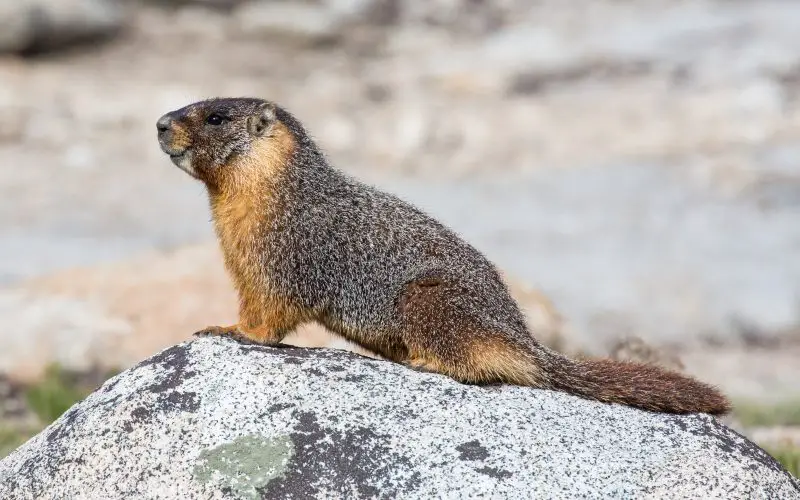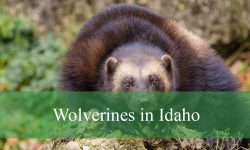Colorado’s mountains hold countless wildlife secrets, but few animals capture people’s attention as consistently as marmots. These stout, bright eyed mammals appear everywhere from boulder fields to alpine meadows, often lounging under sunlight or watching hikers from the edge of rock piles. Their relaxed posture makes them seem simple and predictable, yet their lives revolve around a series of demanding ecological challenges that few mountain animals can handle.
Marmots navigate a world defined by short summers, sudden storms, thin air, and long stretches of winter darkness. Their survival depends on timing, fat storage, communication, and a deep connection to their mountain surroundings. To understand marmots fully, one must look beyond their cheerful demeanor and examine the intricate strategies that anchor them to the high country.
Colorado’s peaks, valleys, and tundra floors tell the story of these remarkable animals. This article reveals the hidden truths behind marmot behavior, their anatomy, their routines, and the delicate ecological balance that allows them to thrive at the top of the Rockies.
Marmots in the Colorado High Country

What Marmots Actually Are
Marmots are large ground dwelling squirrels adapted for rocky landscapes and cold climates. The species most commonly seen in Colorado is the yellow bellied marmot, instantly recognizable by its golden chest patch, grizzled gray back, and expressive face. Adults weigh several pounds, making them one of the heaviest members of the squirrel family.
Their appearance reflects their lifestyle. A marmot’s short legs and compact body help conserve heat. Thick fur and a dense layer of fat protect them during sudden temperature drops at high elevations. Their sharp claws allow them to climb rocks or dig deep into the soil for burrow construction. Every part of their anatomy is built for survival on slopes that challenge even experienced hikers.
Marmots also possess strong awareness of their surroundings. They know where predators perch, how the wind carries scent, and where safe pathways exist among boulders. Their alarm whistles echo across valleys with surprising force and play a key role in maintaining colony safety.
Why Colorado Supports Large Marmot Populations
Colorado is almost tailor made for marmots. The state’s high elevation regions provide exactly the conditions marmots require: cold winters for hibernation, warm summers for rapid feeding, and widespread rocky terrain for protective dens.
The tundra and subalpine meadows create a dependable food supply throughout the warm season. Grasses, wildflowers, and leafy alpine plants grow in abundance once snow melts. These nutrient rich plants allow marmots to gain weight quickly before autumn arrives.
Colorado’s geology also creates perfect shelter. Talus slopes, moraine fields, and boulder clusters provide deep spaces where marmots dig their burrow networks. These underground chambers are crucial for hibernation, predator avoidance, and raising young.
Protected lands amplify this advantage. National parks, wilderness areas, and remote mountain zones give marmots territories largely undisturbed by development. Human visitation grows each year, but most hikers observe marmots from a distance, leaving colonies relatively unaffected.
Where Marmots Live Throughout Colorado
Alpine Meadows and Tundra
Above tree line, marmots often appear on open meadows dotted with wildflowers. The landscape provides sweeping views, abundant plants, and sunlit rocks for basking. Marmots feed intensively in these areas during mornings and afternoons when temperatures are highest.
Subalpine Valleys
Below the alpine zone, marmots occupy grassy clearings, edges of forests, and slopes that receive generous light. The vegetation here grows longer and thicker than on the tundra, offering excellent feeding grounds for families with growing juveniles.
Talus Fields and Rocky Hillsides
Burrows often lie beneath rock piles where gaps between stones create natural insulation. These rocky areas act as central hubs for colonies. Marmots climb onto the highest rocks to scan for danger or warm themselves before feeding.
High Elevation Peaks
Marmots occasionally appear far above typical feeding zones. Some individuals wander across exposed ridgelines, especially during early summer or late autumn when vegetation remains patchy. Their versatility allows them to occupy nearly every mountain zone above about 8,000 feet.
Behavior Patterns Many People Never Notice
A Communication System Built for Safety
Marmots are known for their shrill whistle, but few observers realize how detailed these calls can be. Different sounds correspond to different threats. A short whistle signals a running predator on the ground. A long, wavering call suggests danger from above. Sometimes marmots combine calls or repeat them rapidly to alert juveniles.
These calls ripple through colonies. One marmot calls. Another responds. A third runs into a burrow. Their coordinated behavior forms a protective communication web that reduces risk for every member of the group.
Thermoregulation Through Basking
On high peaks, a sunny rock can make the difference between comfort and hypothermia. Marmots take advantage of the sun’s warmth by stretching across rocks early in the morning. This basking raises their body temperature gradually before they begin feeding. The practice saves energy and reduces stress caused by sharp temperature swings.
When clouds pass or winds pick up, marmots return to warm surfaces or retreat briefly into their burrows.
Social Complexity in Marmot Colonies
Marmots live in loosely structured groups centered on several connected burrows. These communities include dominant adults, breeding females, and younger marmots learning local survival patterns. Although not every member interacts continuously, their behaviors influence one another.
Juveniles observe adult reactions and mimic them. When adults freeze or run, juveniles do the same. When adults choose safe basking areas or foraging patches, younger marmots follow. This learning ensures that each generation inherits not just genes but knowledge.
Anatomy That Helps Marmots Thrive
Fur That Withstands Mountain Winds
The thick fur of a marmot acts like built in insulation. Multiple layers trap warm air near their skin, protecting them from cold mountain nights. This insulation is essential in the early spring when marmots emerge thin and vulnerable after long hibernation.
Claws and Limbs Designed for Burrowing
Marmot burrows can extend deep into the ground and include several chambers. These systems require strength and persistence. Marmots use strong forelimbs and curved claws to dig through soil, gravel, and small stones until they reach adequate depth. Burrows keep marmots safe from predators, storms, and winter cold.
Fat Storage for Winter Survivorship
Hibernation is the defining feature of marmot life. By late summer, marmots accumulate thick layers of fat that carry them through long months underground. Colorado’s alpine winters often last seven or eight months, meaning marmots must store enormous energy reserves.
Their ability to double their body weight before October is one of their most impressive biological feats.
Food and Foraging in Colorado Mountains
Summer Diet Rich in Alpine Plants
Marmots feed primarily on grasses and herbaceous plants. Clover, dandelion, lupine, paintbrush, sedges, and gentians appear frequently in their diets. These plants provide hydration and energy, allowing marmots to gain weight efficiently during short summers.
Feeding With Precision
Marmots do not wander aimlessly while feeding. They choose plants with the highest nutritional value and avoid woody stems or low energy vegetation. Their selective habits maintain meadow health by preventing certain plants from becoming overly dominant.
Seasonal Dietary Changes
Early in the season, marmots rely on tender new leaves and shoots. As plants mature, marmots shift toward tougher grasses and flowering stalks. During late summer, they reduce feeding somewhat and spend more time near burrows as they finish building fat reserves.
Reproduction and Family Life
Spring Mating Upon Emergence
Once marmots emerge from hibernation, breeding begins almost immediately. Males compete for access to females but often do so through displays and dominance rather than aggressive fights.
Nesting in Burrows
Females give birth in protected burrow chambers lined with insulating grasses. These chambers remain hidden from predators and shield pups from unpredictable spring weather.
Rapid Development for Short Seasons
Young marmots must grow quickly to survive. They begin exploring outside the burrow several weeks after birth. By late summer, juveniles feed vigorously, learn to avoid predators, and strengthen their ability to navigate rough terrain.
Marmots Across Colorado’s Geography
Alpine Ridges
These exposed areas provide vantage points for scanning predators. Marmots lounge on rocks here during warm afternoons.
Subalpine Meadows
Lower valleys offer thicker vegetation and longer feeding windows. Families often raise young in these habitats where food remains abundant.
Rocky Slopes and Glacial Deposits
Burrows placed beneath rocks stay warmer in winter and cooler in summer. These slopes serve as central settlement areas for many colonies.
Seasonal Life Patterns
Spring
Marmots emerge thin and confront cold mornings. Feeding becomes urgent, and colonies reform around burrow entrances.
Summer
Activity peaks. Marmots feed intensively, bask regularly, and train juveniles to navigate the landscape.
Autumn
Fat storage increases dramatically. Marmots move less as the season progresses, preparing for winter.
Winter
Hibernation begins. Body temperature, heart rate, and metabolism drop to levels that allow survival underground.
Marmot Interactions With Wildlife
Predators
Coyotes, foxes, eagles, and hawks hunt marmots. Rock piles serve as escape routes, and alarm calls protect colonies.
Grazing Animals
Elk, deer, and sheep share feeding spaces with marmots. Although competition exists, marmots use smaller plant patches that grazers ignore.
Mountain Plants
By consuming selective vegetation, marmots influence which plant species dominate alpine meadows.
Myths and Misunderstandings
Marmots Are Lazy
Resting on rocks is essential for thermoregulation. It saves energy and maintains body temperature efficiently.
Marmots Damage Mountain Ecosystems
Their feeding and burrowing actually support soil aeration and plant diversity.
Marmots Stay Active All Year
They spend more time hibernating than feeding. Their visible season is only a fraction of their yearly cycle.
Ecological Importance
Keeping Meadows Balanced
Feeding habits prevent overstretching of plant populations and support diversity across mountain landscapes.
Soil Turnover Through Burrowing
Marmot burrows help oxygenate soil, influencing how water and nutrients move through alpine ground layers.
Maintaining Predator Populations
Marmots form an important food source for many alpine predators, supporting wildlife balance across high elevations.
FAQs About Marmots in Colorado
Are marmots dangerous?
No. Marmots are shy and avoid humans unless fed, which should be avoided.
What do marmots eat?
They consume grasses, flowers, sedges, and herbaceous plants.
Where can I see them?
Rocky Mountain National Park, San Juan Mountains, the Sawatch Range, and most high elevation meadows.
When are marmots active?
Late morning through afternoon during warm summer months.
Do marmots hibernate?
Yes. Colorado marmots hibernate for most of the year.
Why do marmots whistle?
They use whistles to warn the colony of predators.
Conclusion
Marmots are iconic symbols of the Colorado high country. Their presence brings life to rocky basins, sunny meadows, and towering peaks. Behind their calm expressions lies a sophisticated system of survival grounded in behavior, physiology, and deep connection to the landscape.
Understanding marmots reveals not only their remarkable resilience but also the delicate balance that shapes Colorado’s alpine ecosystems. These animals are far more complex than they appear, and their rhythms offer insight into the mountain world they call home.






